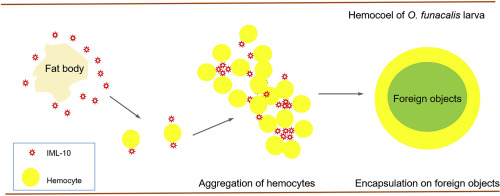当前位置:
X-MOL 学术
›
Insect Biochem. Mol. Biol.
›
论文详情
Our official English website, www.x-mol.net, welcomes your
feedback! (Note: you will need to create a separate account there.)
The C-type lectin IML-10 promotes hemocytic encapsulation by enhancing aggregation of hemocytes in the Asian corn borer Ostrinia furnacalis.
Insect Biochemistry and Molecular Biology ( IF 3.2 ) Pub Date : 2020-01-09 , DOI: 10.1016/j.ibmb.2020.103314 Zhen-Kun Song 1 , Meng-Li Tian 1 , Yi-Pei Dong 1 , Chao-Bo Ren 1 , Yan Du 1 , Jian Hu 1
Insect Biochemistry and Molecular Biology ( IF 3.2 ) Pub Date : 2020-01-09 , DOI: 10.1016/j.ibmb.2020.103314 Zhen-Kun Song 1 , Meng-Li Tian 1 , Yi-Pei Dong 1 , Chao-Bo Ren 1 , Yan Du 1 , Jian Hu 1
Affiliation

|
C-type lectins participate in hemocytic encapsulation as pattern recognition receptors; however, the molecular mechanisms underlying their function remain unknown. In this study, we determined that the encapsulation-promoting function of a C-type lectin, IML-10, may be related to its interaction with hemocytes in the agricultural pest Ostrinia furnacalis. IML-10 possesses two carbohydrate-recognition domains (CRDs) containing EPN and QPD motifs with 4 and 6 conserved cysteine residues, respectively. IML-10 was found to mainly be secreted by the fat body into the larval plasma, and its expression was induced by Sephadex A-25 beads. Anti-IML-10 antibodies inhibited encapsulation-promoting function of IML-10 in the larval plasma. The encapsulation rate of Sephadex A-25 beads decreased from approximately 90%-30% when expression of IML-10 in O. furnacalis larvae was inhibited by RNAi. Moreover, the Sephadex bead-encapsulating ability of hemocytes decreased to almost zero in O. furnacalis larvae with IML-10 knocked out by CRISPR/Cas9, with IML-10 expression clearly decreasing compared to that of the control. Similar to the larval plasma, recombinant IML-10 promoted Sephadex bead encapsulation by hemocytes. Immunohistochemistry analysis showed that IML-10 was able to bind to the surface of both granulocytes and plasmatocytes but not to Sephadex beads as foreign objects. Furthermore, recombinant IML-10 promoted hemocyte aggregation but not adhesion. Therefore, we speculate that IML-10 binds to the surface of hemocytes to promote their aggregation and further improve their encapsulation capacity. These results contribute to clarifying the function of insect C-type lectins in encapsulation.
中文翻译:

C型凝集素IML-10通过增强亚洲玉米bore的Ostrinia furnacalis中的血细胞聚集来促进血细胞性囊化。
C型凝集素作为模式识别受体参与血细胞的囊化。然而,其功能的分子机制仍然未知。在这项研究中,我们确定了C型凝集素IML-10的促包囊功能可能与其与农业害虫Ostrinia furnacalis中的血细胞相互作用有关。IML-10拥有两个碳水化合物识别结构域(CRD),分别包含EPN和QPD基序,分别具有4和6个保守的半胱氨酸残基。发现IML-10主要由脂肪体分泌到幼虫血浆中,并且其表达由Sephadex A-25珠诱导。抗IML-10抗体抑制了幼虫血浆中IML-10的促包囊功能。当在O中表达IML-10时,Sephadex A-25珠的包封率从大约90%-30%降低。呋喃卡虫幼虫被RNAi抑制。此外,在CRISPR / Cas9敲除IML-10的糠O幼虫中,血细胞对Sephadex珠的包封能力几乎降低至零,与对照相比,IML-10表达明显降低。与幼虫血浆相似,重组IML-10促进了血细胞对Sephadex珠的包裹。免疫组织化学分析表明,IML-10能够结合粒细胞和浆细胞的表面,但不能结合作为异物的Sephadex珠。此外,重组IML-10促进血细胞聚集,但不促进黏附。因此,我们推测IML-10结合到血细胞表面,以促进其聚集并进一步提高其封装能力。这些结果有助于阐明昆虫C型凝集素在包封中的功能。
更新日期:2020-01-09
中文翻译:

C型凝集素IML-10通过增强亚洲玉米bore的Ostrinia furnacalis中的血细胞聚集来促进血细胞性囊化。
C型凝集素作为模式识别受体参与血细胞的囊化。然而,其功能的分子机制仍然未知。在这项研究中,我们确定了C型凝集素IML-10的促包囊功能可能与其与农业害虫Ostrinia furnacalis中的血细胞相互作用有关。IML-10拥有两个碳水化合物识别结构域(CRD),分别包含EPN和QPD基序,分别具有4和6个保守的半胱氨酸残基。发现IML-10主要由脂肪体分泌到幼虫血浆中,并且其表达由Sephadex A-25珠诱导。抗IML-10抗体抑制了幼虫血浆中IML-10的促包囊功能。当在O中表达IML-10时,Sephadex A-25珠的包封率从大约90%-30%降低。呋喃卡虫幼虫被RNAi抑制。此外,在CRISPR / Cas9敲除IML-10的糠O幼虫中,血细胞对Sephadex珠的包封能力几乎降低至零,与对照相比,IML-10表达明显降低。与幼虫血浆相似,重组IML-10促进了血细胞对Sephadex珠的包裹。免疫组织化学分析表明,IML-10能够结合粒细胞和浆细胞的表面,但不能结合作为异物的Sephadex珠。此外,重组IML-10促进血细胞聚集,但不促进黏附。因此,我们推测IML-10结合到血细胞表面,以促进其聚集并进一步提高其封装能力。这些结果有助于阐明昆虫C型凝集素在包封中的功能。











































 京公网安备 11010802027423号
京公网安备 11010802027423号